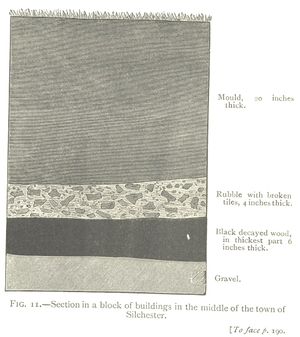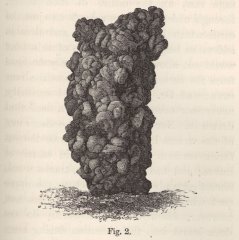Vegetable Mould: Difference between revisions
m The LinkTitles extension automatically added links to existing pages (https://github.com/bovender/LinkTitles). |
|||
| (15 intermediate revisions by 3 users not shown) | |||
| Line 1: | Line 1: | ||
==Definition== | ==Definition== | ||
[[File:vegetable.jpg|thumb|right|Image from Darwin's book, The Formation of Vegetable Mould through the Action of Worms, with Observations on their Habits | [[File:vegetable.jpg|thumb|right|Image from Darwin's book, The Formation of Vegetable Mould through the Action of Worms, with Observations on their Habits [7]]] | ||
Vegetable mould is the layer of dark colored, uniformly fine soil particles that cover the surface of land in moderately humid climates. This layer of mould, known as a form of soil [[humus]], can reach a depth of 40 cm or more in the soil profile. Earthworm secretions (or castings) primarily compose vegetable mould, and the layer is a few inches thick. Vegetable mould is located in the O Horizon of the [[Soil Horizons]]. | Vegetable mould is the layer of dark colored, uniformly fine soil particles that cover the surface of land in moderately humid climates. This layer of mould, known as a form of soil [[humus]], can reach a depth of 40 cm or more in the soil profile. [[Earthworm]] secretions (or castings) primarily compose vegetable mould, and the layer is a few inches thick. Vegetable mould is located in the O Horizon of the [[Soil Horizons]]. | ||
== | ==Earthworm Contribution== | ||
Earthworms sift | Earthworms sift finer soils from coarser soils, mix the soil with mineral particles, and saturate it with intestinal secretion. Earthworm burrowing, casting, grazing, and dispersal change the soil's physico-chemical and biological status and could cause drastic shifts in the density, [[diversity]], structure and activity within the [[drilosphere]]. [1] While feeding, earthworms promote microbial activity that accelerate the rates of breakdown and stabilization of humic portions of [[Organic Matter|organic matter]]. | ||
[[File:wormss.jpg|frame|left|Drawing of earthworm castings | [[File:wormss.jpg|frame|left|Drawing of earthworm castings [7]]] | ||
==Observations and Experiments== | ==Observations and Experiments== | ||
Charles Darwin first noted the importance of earthworm species in the creation of vegetable mould in his book, “The Formation of Vegetable Mould, through the Action of Worms, with Observations on their Habits”. [2] Darwin cited results from a number of his experiments which showed | [[Charles Darwin]] first noted the importance of earthworm species in the creation of vegetable mould in his book, “The Formation of Vegetable Mould, through the Action of Worms, with Observations on their Habits”. [2] Darwin cited results from a number of his experiments which showed that 0.5 cm of soil is brought to the surface in worm casts annually. Most earthworms live at a soil depth of 25-30 cm; therefore, this surface soil is worked over the most thoroughly. [3] Darwin has observed through experiments a value of 18.12 tons of earth per acre is brought to the surface in dry casts. The constant production of vegetable mould by earthworms can be observed by the estimated rate at which objects on the surface are buried and by weighing the earth brought up in a given time. Vegetable mould and worms are also able to preserve ancient objects under the ground. This happens due to objects being surrounded by worm castings and excretions of the vegetable mould. [3] | ||
[[File:Veggie.jpeg|frame|120x60px|]] | [[File:Veggie.jpeg|frame|120x60px|[7]]] | ||
==Mould Benefits== | ==Mould Benefits== | ||
Vegetable mould creates fertile soil. Earthworms prepare the ground for the growth of fibrous-rooted plants and many types of seedlings | Vegetable mould creates fertile soil. Earthworms prepare the ground for the growth of fibrous-rooted plants and many types of seedlings by helping to expose and sift the vegetable mould. With vegetable mould, soil is in a state fitted to retain moisture and absorb soluble substances. [4] Nitrification is possible with vegetable mould in soil as well. The constant movement by worms in soil allows for materials to be buried beneath accumulated castings of worms, and then brought to a decayed state. [5] All humic substances are able to chelate soil nutrients and act as a storehouse of nitrogen, phosphorus, sulphur and zinc. Humic substances can also improve nutrient uptake, especially phosphorous, sulfur, and nitrogen. [6] | ||
==See also== | |||
*[[Soil]] | |||
*[[Soil Horizons]] | |||
*[[Soil Textures]] | |||
*[[Founders of Soil Concepts]] | |||
*[[Humus]] | |||
*[[Annelids]] | |||
*[[Animals]] | |||
==References== | ==References== | ||
[1] | [1] | ||
Edwards, Clive A., ed. Earthworm ecology. CRC press, 2004. | Edwards, Clive A., ed. Earthworm [[ecology]]. CRC press, 2004. | ||
[2] | [2] | ||
| Line 38: | Line 48: | ||
[6] | [6] | ||
Mayhew, Lawrence. "Humic substances in biological agriculture." Rev ACRES 34.1-2 (2004): 80-88. | Mayhew, Lawrence. "Humic substances in biological [[agriculture]]." Rev ACRES 34.1-2 (2004): 80-88. | ||
[7] | |||
“THE FORMATION OF VEGETABLE MOULD THROUGH THE ACTION OF WORMS WITH OBSERVATIONS ON THEIR HABITS.” The Formation of Vegetable Mould, by Charles Darwin, www.gutenberg.org/files/2355/2355-h/2355-h.htm. | |||
Latest revision as of 14:18, 2 May 2025
Definition

Vegetable mould is the layer of dark colored, uniformly fine soil particles that cover the surface of land in moderately humid climates. This layer of mould, known as a form of soil humus, can reach a depth of 40 cm or more in the soil profile. Earthworm secretions (or castings) primarily compose vegetable mould, and the layer is a few inches thick. Vegetable mould is located in the O Horizon of the Soil Horizons.
Earthworm Contribution
Earthworms sift finer soils from coarser soils, mix the soil with mineral particles, and saturate it with intestinal secretion. Earthworm burrowing, casting, grazing, and dispersal change the soil's physico-chemical and biological status and could cause drastic shifts in the density, diversity, structure and activity within the drilosphere. [1] While feeding, earthworms promote microbial activity that accelerate the rates of breakdown and stabilization of humic portions of organic matter.

Observations and Experiments
Charles Darwin first noted the importance of earthworm species in the creation of vegetable mould in his book, “The Formation of Vegetable Mould, through the Action of Worms, with Observations on their Habits”. [2] Darwin cited results from a number of his experiments which showed that 0.5 cm of soil is brought to the surface in worm casts annually. Most earthworms live at a soil depth of 25-30 cm; therefore, this surface soil is worked over the most thoroughly. [3] Darwin has observed through experiments a value of 18.12 tons of earth per acre is brought to the surface in dry casts. The constant production of vegetable mould by earthworms can be observed by the estimated rate at which objects on the surface are buried and by weighing the earth brought up in a given time. Vegetable mould and worms are also able to preserve ancient objects under the ground. This happens due to objects being surrounded by worm castings and excretions of the vegetable mould. [3]

Mould Benefits
Vegetable mould creates fertile soil. Earthworms prepare the ground for the growth of fibrous-rooted plants and many types of seedlings by helping to expose and sift the vegetable mould. With vegetable mould, soil is in a state fitted to retain moisture and absorb soluble substances. [4] Nitrification is possible with vegetable mould in soil as well. The constant movement by worms in soil allows for materials to be buried beneath accumulated castings of worms, and then brought to a decayed state. [5] All humic substances are able to chelate soil nutrients and act as a storehouse of nitrogen, phosphorus, sulphur and zinc. Humic substances can also improve nutrient uptake, especially phosphorous, sulfur, and nitrogen. [6]
See also
References
[1] Edwards, Clive A., ed. Earthworm ecology. CRC press, 2004.
[2] Darwin, Charles, 1809-1882. The Formation of Vegetable Mould, through the Action of Worms, with Observations on their Habits. J. Murray, London, 1892.
[3] Hayes, M. B. "Darwin’s ‘vegetable mould’ and some modern concepts of humus structure and soil aggregation." Earthworm Ecology. Springer, Dordrecht, 1983. 19-33.
[4] Martin, J. P., and K. Haider. "Microbial activity in relation to soil humus formation." Soil Science 111.1 (1971): 54-63.
[5] Wild, Alan. Soils and the Environment: An Introduction. Cambridge University Press, New York, NY, USA;Cambridge;, 1993.
[6] Mayhew, Lawrence. "Humic substances in biological agriculture." Rev ACRES 34.1-2 (2004): 80-88.
[7] “THE FORMATION OF VEGETABLE MOULD THROUGH THE ACTION OF WORMS WITH OBSERVATIONS ON THEIR HABITS.” The Formation of Vegetable Mould, by Charles Darwin, www.gutenberg.org/files/2355/2355-h/2355-h.htm.